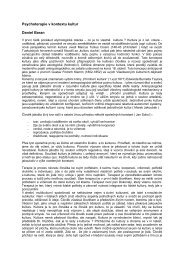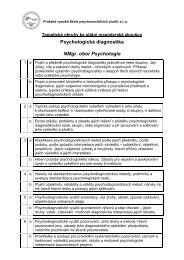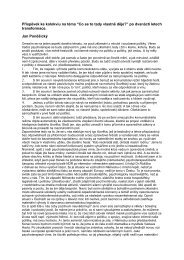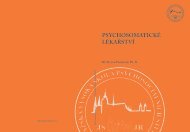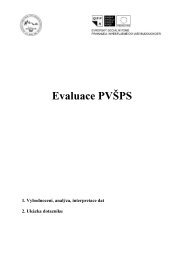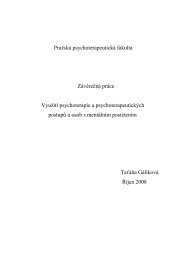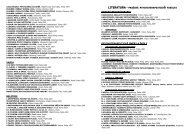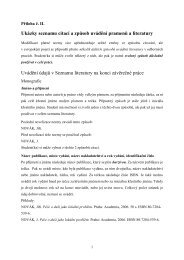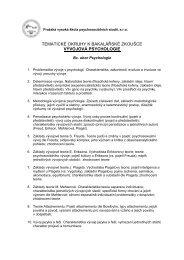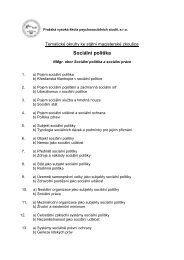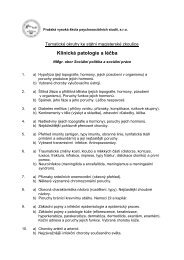New Sources of Fear in a Late Modern Society: The Globalization of ...
New Sources of Fear in a Late Modern Society: The Globalization of ...
New Sources of Fear in a Late Modern Society: The Globalization of ...
You also want an ePaper? Increase the reach of your titles
YUMPU automatically turns print PDFs into web optimized ePapers that Google loves.
112<br />
NEW SOURCES OF FEAR IN A LATE MODERN SOCIETY<br />
– we focus on the everyday and its problems; on surviv<strong>in</strong>g, which creates a desensitiz<strong>in</strong>g<br />
that reflects <strong>of</strong>ten deeply concealed anxieties, which repeatedly come<br />
to the conscious surface <strong>in</strong> some <strong>in</strong>dividuals. A pragmatic acceptance is paired<br />
either with concealed pessimism, or with us<strong>in</strong>g hope as a founta<strong>in</strong> <strong>of</strong> survival<br />
and both conditions can coexist <strong>in</strong> an ambivalent state. <strong>The</strong> author describes the<br />
second adaptive reaction as susta<strong>in</strong>ed optimism, underscored by faith and rationalism<br />
and <strong>in</strong> the f<strong>in</strong>d<strong>in</strong>g <strong>of</strong> social and technological solutions to global problems,<br />
while science is viewed as a source <strong>of</strong> long-term security. <strong>The</strong> third, entirely the<br />
opposite <strong>of</strong> optimism, is a cynical pessimism, but is not categorized as <strong>in</strong>difference.<br />
As Giddens (1998) po<strong>in</strong>ts out, cynicism is a form <strong>of</strong> eas<strong>in</strong>g the emotional<br />
impact <strong>of</strong> various concerns, either with the help <strong>of</strong> humor, or with a reaction and<br />
answer replete with distaste at the world. In several <strong>of</strong> its forms, cynicism is separable<br />
from pessimism and can <strong>in</strong>stead coexist with a certa<strong>in</strong> frustrated sense <strong>of</strong><br />
hope. Pessimism is not a guide as to how to react and <strong>in</strong> an extreme form can<br />
only lead to a paralyz<strong>in</strong>g depression. In connection with cynicism, however, pessimism<br />
enables a position that has practical effects. Cynicism blunts pessimism,<br />
because it neutralizes the emotions and is source <strong>of</strong> humor. A radical engagement<br />
is the fourth adaptive reaction, which presents the realization <strong>of</strong> a practical battle<br />
aga<strong>in</strong>st great and oppressive problems and an effort to overcome them (Giddens,<br />
1998). Pragmatic acceptance, susta<strong>in</strong>ed optimism, cynical pessimism and radical<br />
engagement described as adaptive reactions to the risks <strong>of</strong> modernity, also serve to<br />
express concrete strategies that a person uses to face a flood <strong>of</strong> threaten<strong>in</strong>g <strong>in</strong>formation<br />
(about both real and unreal dangers). <strong>The</strong> aforementioned strategies also<br />
encompass methods <strong>of</strong> cop<strong>in</strong>g with fear.<br />
Giddens (2000) differentiates between external risk, presented by tradition or nature<br />
(a poor harvest, floods, epidemics, fam<strong>in</strong>e etc.), and manufactured risks, which<br />
are dom<strong>in</strong>ant <strong>in</strong> contemporary society. It is crucial to understand that the level <strong>of</strong><br />
human engagement with nature is so extensive that many external risk factors are<br />
<strong>in</strong> actuality a likely result <strong>of</strong> human activities, mean<strong>in</strong>g that we could also – at least<br />
<strong>in</strong> certa<strong>in</strong> cases – place them <strong>in</strong> the category <strong>of</strong> manufactured risks. Politicians, scientists<br />
and other experts have encountered a new moral dilemma between creat<strong>in</strong>g<br />
mass hysteria on the one hand and conceal<strong>in</strong>g the true extent <strong>of</strong> a given problem on<br />
the other. What is problematic is the certa<strong>in</strong>ty – or perhaps lack <strong>of</strong> certa<strong>in</strong>ty – that<br />
relates to the true state <strong>of</strong> affairs, whilst at the same time, it is true that we cannot and<br />
will not be entirely certa<strong>in</strong> until it is too late, argues Giddens (2000). It is crucial to<br />
add that dur<strong>in</strong>g efforts to achieve certa<strong>in</strong>ty, from an empirical standpo<strong>in</strong>t, we prefer<br />
the most complete description <strong>of</strong> a given phenomena, while at the same time resign<strong>in</strong>g<br />
to <strong>in</strong>tuition and common sense enabl<strong>in</strong>g us to understand various causes. As the<br />
complexity <strong>of</strong> a given problem <strong>in</strong>creases, so do the difficulties <strong>in</strong> creat<strong>in</strong>g a complete<br />
empirical description. This means that a given phenomena is wrenched from the



